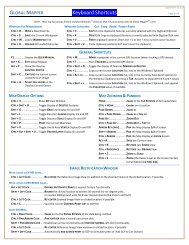Map GPS Coordinates - GPS Map Coordinates ... - Global Mapper
Map GPS Coordinates - GPS Map Coordinates ... - Global Mapper
Map GPS Coordinates - GPS Map Coordinates ... - Global Mapper
You also want an ePaper? Increase the reach of your titles
YUMPU automatically turns print PDFs into web optimized ePapers that Google loves.
necessary if you have overlapping areas that do not display in the correct order without this option checked. If<br />
point features are drawn above the terrain, the Extrude Points option allows you to control whether or not a<br />
thin line is drawn from the terrain surface at the location of the point to the floating symbol above the terrain<br />
surface. Enabling this option makes it easier to locate exactly where a point lies relative to the surface.<br />
The Filled Area Translucency section allows the user to control the degree to which filled polygons are<br />
see-through in the created file.<br />
The Feature Descriptions section allows you to setup what is contained in the description for each feature in<br />
the generated file. You can choose to include only the feature description and links to any files associated with<br />
a feature, you can choose to add attributes to this, or you can choose to provide your own HTML text to use<br />
for the feature description. If you use the HTML text option, you can embed the values of attributes from the<br />
feature in the text by enclosing the attribute name in percent signs, like %ATTR_NAME%. In addition to the<br />
name of attributes, you can also specify , , , , or<br />
as the attribute name to get the feature display label, description, type name, point longitude, or<br />
point latitude embedded in the result. If you need to embed an actual percent sign in your result, simply use<br />
two percent signs consecutively as an escape sequence.<br />
The following additional options are also available:<br />
<strong>Global</strong> <strong>Map</strong>per User's Manual<br />
• Character Encoding - this option controls the character encoding value encoded in the header of the<br />
KML file. You will typically just keep the default of iso-8859-1, but if your loaded data includes text<br />
encoded with a different character set, like UTF-8, you can select that or even type in your own<br />
encoding if something else fits your data best.<br />
• Create Compressed KMZ File - if this option is checked, a compressed KMZ file will automatically<br />
be created. This will result in much smaller files and is highly recommended unless you plan on<br />
manually editing the export result yourself in a text editor.<br />
• Hide Point Features by Default When Loading File - if this option is checked, all of the point features<br />
exported to the file will be hidden by default in Google Earth so as not to clutter up the display with a<br />
bunch of point icons.<br />
• Use Displayed Point Symbols Rather than Push-Pins for Points - if this option is checked, each point<br />
feature will be rendered with the same symbol displayed in <strong>Global</strong> <strong>Map</strong>per rather than using the<br />
default push-pin symbol from Google Earth. This will result in a separate PNG file for each symbol<br />
used in the output file being included with the output data to provide the symbols.<br />
• Display Area and Line Labels - if this option is checked, each exported line or area feature with a<br />
display label will also be marked with a clickable placemark displaying the label for that area or line<br />
feature. This is the only way to get line or area features to display labels in Google Earth.<br />
• Highlight Areas in Google Earth when the Cursor Goes Over Them - if this option is checked, area<br />
features will highlight when you move your cursor over them in Google Earth. In addition, if you<br />
checked the option to display area and line labels, the area label will be hidden until you mouse over<br />
the area, at which time the label will popup.<br />
• Generate Index KML File - if this option is checked, an additional index KML file will be generated<br />
which indexes all tiles exported by the export command. This is very useful for dealing with very<br />
large data sets as it will automatically load and unload individual KML tiles as needed for display in<br />
Google Earth, much as a map catalog does in <strong>Global</strong> <strong>Map</strong>per. With this option you can load massive<br />
data sets into Google Earth and they will still display quickly. The drawing style of the index tiles is<br />
controlled by the selected drawing style for the Coverage/Quad area type on the Area Styles tab of the<br />
Configuration dialog.<br />
For advanced users, you can also customize what is displayed in the balloon text that appears in Google Earth<br />
when you click on a point. You are able to customize the tag to use text with the string value<br />
<strong>Map</strong> <strong>GPS</strong> <strong>Coordinates</strong> - <strong>GPS</strong> <strong>Map</strong> <strong>Coordinates</strong> - <strong>GPS</strong> <strong>Coordinates</strong> <strong>Map</strong> 60







